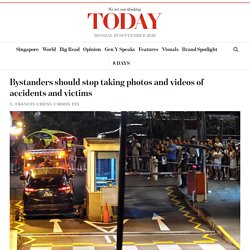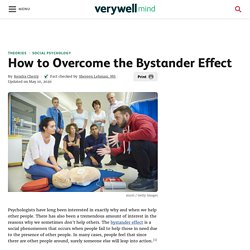

If you have encountered one of the situation above and stood by as an “observer”, then you are guilty of committing the Bystander Effect.
Do we understand more of it and is it a normal behavior?
And has the uprising of technology made it worse?
The Bystander Effect. The Science of Empathy. Singaporean Eye Power (feat. Steven Lim)
New York Today: The City’s Bystander Effect. Good morning on this clear Monday.

The first time I dialed 911 in New York was on a subway platform at 42nd Street — last week. A woman was bleeding on her head and neck; she had fallen on the stairs between the platform and turnstiles. Some passengers hurried past her. An avoidable murder of a student caught on tape: the sickening power of the bystander effect.
On Sept. 17, the life of a 16-year-old high schooler in Long Island ended tragically in a violent brawl outside a strip mall.

Khaseen Morris was told to show up outside the mall at a certain time by several others his age, after he was seen walking home the girlfriend of another boy. Morris showed up and was immediately attacked by a group of five teenagers. A senseless brawl erupted and Morris was stabbed repeatedly in the chest, dying later that night in the hospital. The tragedy of Morris’s murder extends beyond the senselessness of his violent death and the fact that an innocent young life ended so abruptly over a trivial adolescent dispute.
TODAYonline. I refer to the news reports of the fatal traffic accident on Sunday (Dec 29) at Lucky Plaza.

I applaud the Good Samaritans who unselfishly helped to lift up the car, pulled the victims out and attended to them. These are acts of true heroism. Man disappointed after crowd took photos of accident victim instead of helping to lift bus, Singapore News. SINGAPORE (THE NEW PAPER) - Mr Albert Leow was at home when he heard a loud crash. When he looked out the window, he was horrified to see a man pinned under an SBS Transit double-decker bus. Mr Leow called the police and rushed down to help the victim. Recalling a video showing a group of people lifting a lorry to free a trapped victim in an accident in July last year, Mr Leow, 41, thought the 20 to 30 people who had gathered there could do the same. But he was dismayed when several of them were more interested in taking pictures and videos of the trapped man instead of helping him. His HDB flat at Block 662, Hougang Avenue 9, overlooks the scene of the accident, which occurred opposite Ci Yuan Community Club at 10.30am on Sept 30.
TO TAKE PHOTOS OR HELP? A pedestrian, Mr Lim Chin Soon, 51, was trapped under the front left wheel of SBS Transit Bus Service 72. Mr Leow, who runs a car workshop, told The New Paper on Tuesday: “At first, I thought his head was pinned beneath the wheel.” K-pop deaths renew focus on cyber bullying of young stars and lack of punishment.
The apparent suicide of a second K-pop artist in six weeks has cast renewed focus in South Korea on cyber bullying of vulnerable young stars, and how it mostly goes unpunished.

South Korean police consider cyber violence a serious crime and have an active programme educating the public how not to fall prey to online attacks, or to become the perpetrator. Charges laid are steadily on the rise with nearly 150,000 cases last year, but they form just a tiny part of what goes on and there is no good recourse for the victims in a country once touted as one of the most wired on earth, police say.
“It’s rather simple with physical violence, as the victim can go see a doctor, but with cyber violence, there is no cure,” says Jeon Min-su, a cybercrime investigator with the Seoul Metropolitan Police Agency. Hana Kimura: Netflix star and Japanese wrestler dies at 22. Image copyright Getty Images Hana Kimura, a professional Japanese wrestler who appeared in the latest series of Netflix's reality show Terrace House, has died at the age of 22.

Stardom Wrestling, Kimura's organisation, confirmed the news and asked fans to be respectful. The cause of death was not immediately clear. Reuters. You Are What You Read: The Belief Systems of Cyber-Bystanders on Social Networking Sites. Introduction The increase in cyberbullying on social network sites (SNS) has become a significant risk for the mental and physical health of adolescents in the United States and in many countries around the world (Patchin and Hinduja, 2012).

Youth who are victims of cyberbullying suffer from numerous negative outcomes (anxiety, fear, depression, and low self-esteem) and they often struggle academically (Schneider et al., 2011). In a large-scale study of adolescents’ online behavior, Lenhart et al. (2011) found that while 88% had witnessed cyberbullying, most reported that they had ignored the bullying (90%), 67% had seen others join in, 21% had joined in themselves, and about 25% had defended the victim.
Although prevalence rates have been well documented at present, we know little about the behavior of individuals who witness bullying in online contexts, and why or how they choose to respond. Social norms may also influence bystanders’ decision to join in with cyberbullying. FIGURE 1. Cyber-bullying: An exploration of bystander behavior and motivation. Emily Shultz1, Rebecca Heilman2, Kathleen J.

Hart3 1,2,3 Xavier University, Cincinnati, OH, USA Abstract While previous research has examined mainly self-reported bystander behavior during cyber-bullying, the current study explored if and how bystanders responded when presented with a cyber-bullying simulation. We hypothesized that individuals high in empathy would supportively intervene (defend the victim) most frequently. Keywords: Cyber-bullying; bystander; intervention; motivation Introduction As society continues to embrace communication on social-networking sites, cyber-bullying (CB) has become a more common occurrence and a substantial concern. The Dangerous Side of Social Media: Manipulating Bystander Aggres. Bystander Revolution: Dr. Philip Zimbardo.
How to Overcome the Bystander Effect. Psychologists have long been interested in exactly why and when we help other people.

There has also been a tremendous amount of interest in the reasons why we sometimes don't help others. The bystander effect is a social phenomenon that occurs when people fail to help those in need due to the presence of other people. In many cases, people feel that since there are other people around, surely someone else will leap into action.1 While the bystander effect can have a negative impact on prosocial behavior, altruism and heroism, researchers have identified a number of different factors that can help people overcome this tendency and increase the likelihood that they will engage in helping behaviors.2 Some of these include: Witnessing Helping Behavior Sometimes just seeing other people doing something kind or helpful makes us more willing to help others.
Active bystander. How Bystanders can Help Stop Cyberbullying – Social Media Stories. “Someone made an Instagram account that said: “You’re a slut and you should kill yourself.” And I was the only person they followed.” In 2016, social media and mobile apps have made it simple, cost-effective, and fun to connect with anyone, anywhere. 3 Ways to Become an Upstander. Upstanding by Design Bystander Intervention in Cyb. Upstanding by Design: Bystander Intervention in Cyberbullying.